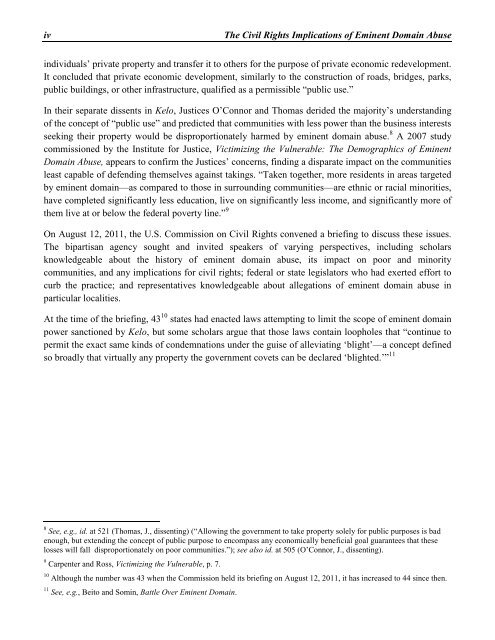Executive SummaryiiiEXECUTIVE SUMMARYThe Fifth Amendment to the U.S. Constitution states that government shall not take private propertyexcept for “public use” and with “just compensation.” 1 In Berman v. Parker, 2 the Supreme Court heldthat eliminating blight qualifies as a permissible “public use” under the Fifth Amendment. In so doing,the Berman Court permitted Washington, DC, to take a department store that was not itself in poorcondition and to transfer it to a private development corporation for the purpose of curing blight in thesurrounding neighborhood, in which most of the residences were considered uninhabitable and beyondrepair. Pursuant to that decision, the District of Columbia was able to expel some 5,000 low-incomeblacks from their homes in the name of “urban renewal.” 3 Critics argue that the decision opened the doorto the use (or abuse) of eminent domain by expanding the term “public use” to mean “public purpose”—an interpretation that they believe has no constitutional basis.Subsequent to the Berman decision, state court decisions invoked “public use” broadly. They concludedthat possible “public benefits” from increased tax revenues or job creation, which could flow from amore desirable private owner (such as a large business), justified the transfer of private property fromone owner to another through eminent domain, regardless of the property’s condition. 4Some civil rights advocates have argued that local governments historically used the urban renewalcondemnations Berman permitted to target racial and ethnic minorities. “Indeed, the displacement ofAfrican Americans and urban renewal projects were so intertwined that ‘urban renewal’ was oftenreferred to as ‘Negro removal.’” 5 Too often, “blight,” a facially-neutral word, masked the discriminatorymotives behind certain takings. 6 Today, some critics claim that officials often declare areas blighted and,therefore, in need of redevelopment that are not actually blighted, and the owners seldom receive justcompensation. Critics also charge that the burden falls disproportionately on those lacking the money,political power, and influence needed to rebuff attempted takings, with the “deck stacked against”property owners.In 2005, the Supreme Court affirmed its broad interpretation of “public use” in Kelo v. City of NewLondon. 7 A divided (5-4) Court upheld the use of eminent domain by local governments to take1 “Nor shall private property be taken for public use, without just compensation.” U.S. CONST. amend. V.2 348 U.S. 26 (1954).3 David Beito and Ilya Somin, “Battle Over <strong>Eminent</strong> <strong>Domain</strong> is Another Civil Rights Issue,” Kansas City Star, Apr. 27, 2008,available at http://www.cato.org/pub_display.php?pub_id=9361.4 See Dick M. Carpenter and John K. Ross, Institute for Justice, Victimizing the Vulnerable: The Demographics of <strong>Eminent</strong><strong>Domain</strong> Abuse, June 2007, p. 3.5 Brief for Nat’l Ass’n for the Advancement of Colored People et al. as Amici Curiae Supporting Petitioners at 7, in Kelo v.New London, 545 U.S. 469 (2005) (No. 04-108), available athttp://www.ij.org/images/pdf_folder/private_property/kelo/naacp02.pdf.6 See id. (citing Wendell E. Pritchett, The “Public Menace” of Blight: Urban Renewal and the Private Uses of <strong>Eminent</strong><strong>Domain</strong>, 21 YALE L. & POL’Y REV. 1, 6 (2003)).7 545 U.S. 469 (2005).
ivThe Civil Rights Implications of <strong>Eminent</strong> <strong>Domain</strong> Abuseindividuals’ private property and transfer it to others for the purpose of private economic redevelopment.It concluded that private economic development, similarly to the construction of roads, bridges, parks,public buildings, or other infrastructure, qualified as a permissible “public use.”In their separate dissents in Kelo, Justices O’Connor and Thomas derided the majority’s understandingof the concept of “public use” and predicted that communities with less power than the business interestsseeking their property would be disproportionately harmed by eminent domain abuse. 8 A 2007 studycommissioned by the Institute for Justice, Victimizing the Vulnerable: The Demographics of <strong>Eminent</strong><strong>Domain</strong> Abuse, appears to confirm the Justices’ concerns, finding a disparate impact on the communitiesleast capable of defending themselves against takings. “Taken together, more residents in areas targetedby eminent domain—as compared to those in surrounding communities—are ethnic or racial minorities,have completed significantly less education, live on significantly less income, and significantly more ofthem live at or below the federal poverty line.” 9On August 12, 2011, the U.S. Commission on Civil Rights convened a briefing to discuss these issues.The bipartisan agency sought and invited speakers of varying perspectives, including scholarsknowledgeable about the history of eminent domain abuse, its impact on poor and minoritycommunities, and any implications for civil rights; federal or state legislators who had exerted effort tocurb the practice; and representatives knowledgeable about allegations of eminent domain abuse inparticular localities.At the time of the briefing, 43 10 states had enacted laws attempting to limit the scope of eminent domainpower sanctioned by Kelo, but some scholars argue that those laws contain loopholes that “continue topermit the exact same kinds of condemnations under the guise of alleviating ‘blight’—a concept definedso broadly that virtually any property the government covets can be declared ‘blighted.’” 118 See, e.g., id. at 521 (Thomas, J., dissenting) (“Allowing the government to take property solely for public purposes is badenough, but extending the concept of public purpose to encompass any economically beneficial goal guarantees that theselosses will fall disproportionately on poor communities.”); see also id. at 505 (O’Connor, J., dissenting).9 Carpenter and Ross, Victimizing the Vulnerable, p. 7.10 Although the number was 43 when the Commission held its briefing on August 12, 2011, it has increased to 44 since then.11 See, e.g., Beito and Somin, Battle Over <strong>Eminent</strong> <strong>Domain</strong>.


